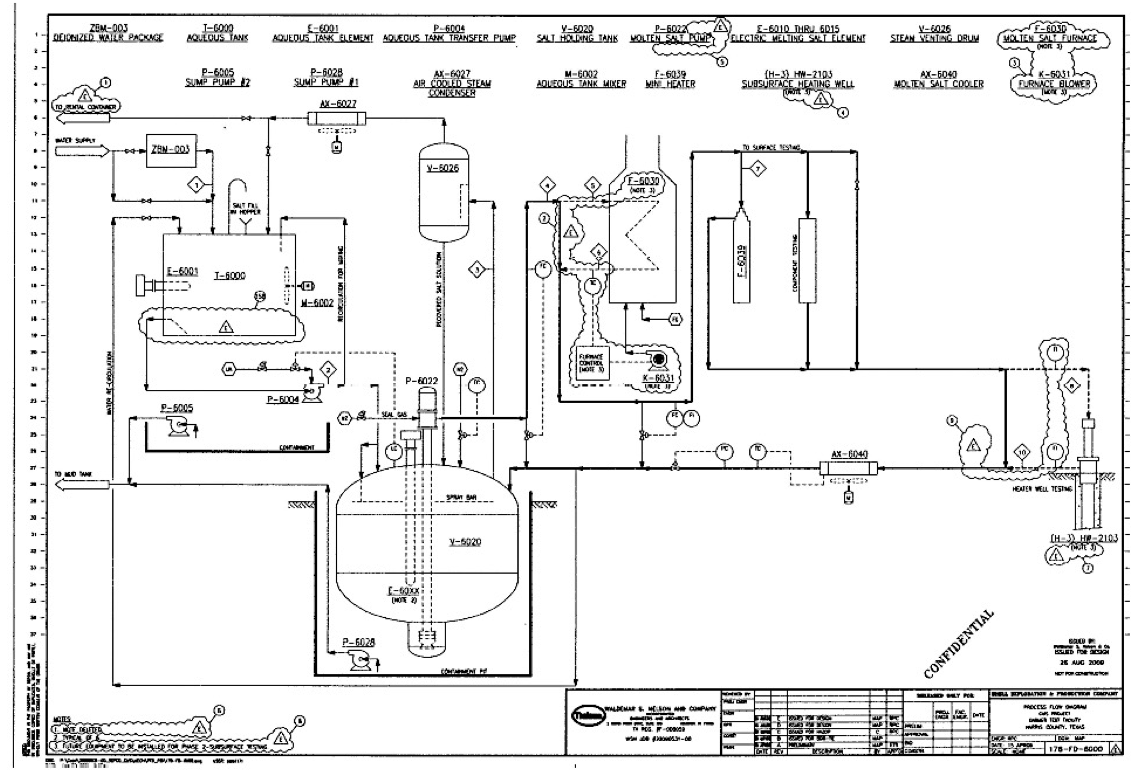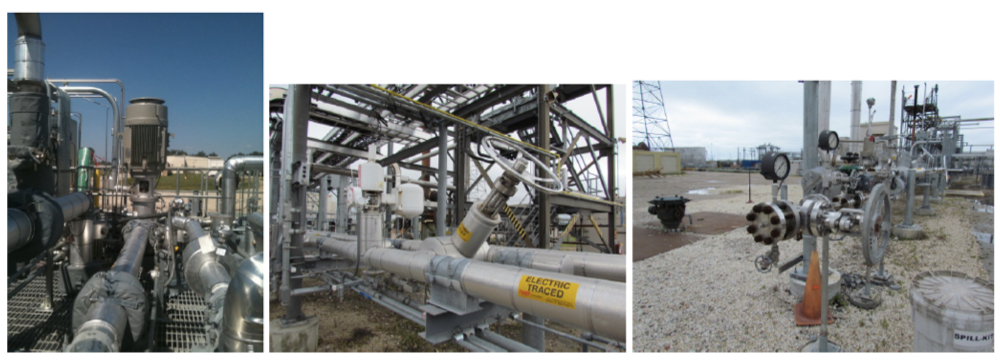High Temperature Molten Salt Technology Center
Peter McIntyre and Daniel Barth
Texas A&M University proposes to create a Molten Salt Technology Center as a national center for development of molten salt technology for energy and industrial applications. Its mission will include development of new technology utilizing molten salt, testing of molten salt systems and components in flow loops and process simulations at temperatures up to 1000 C, and training of students and technologists for careers in applying molten salt for practical applications.
Molten salt technology is today becoming increasingly important in a number of important applications:
- Efficient recoverable high-temperature heat storage to load-level solar power production [1];
- Molten-salt cores and heat transfer for a new generation of safe, efficient nuclear power [2];
- High-volume heat transfer for secondary recovery of oil and tar sands [3];
- High-efficiency non-acid synthesis of phosphate fertilizers;
- Salt melt synthesis of ceramics, semiconductors and carbon nanostructures [4].
As we have worked with companies in every one of the above applications, we find a need for trained engineers and operating personnel and very few universities with the expertise among their faculty and facilities that can provide hands-on experience for their students. At the application end, that need compounds with the need for scientists, engineers, and technologists who will link high-temperature molten salt as a heat transfer medium to end-point equipment for minerals recovery, energy production and storage, and materials processing. There is a natural opportunity for interdisciplinary education and research among physics, nuclear engineering, chemical engineering, and petroleum engineering wherever they intersect high heat transfer using molten salts.
The centerpiece of the Center is a proposed gift of a large (3 m diameter) molten-salt flow loop from Shell Oil Company. The system as presently configured can support large-flow testing of molten salt components in conditions that can simulate a gamut of process applications. The vessel and components are rated for operation to ~750 C, and we are designing an insert liner vessel that would enable operation up to 1000 C.
A second capability is a set of medium-scale (~50 kG capacity) molten-salt vessels, with provisions for interconnection so that it the can be configured as a flow loop, a heat exchanger, a test fixture for valves or pumps, corrosion experiments, methods for separating dispersions of micro- or nano-particles, and measurement of viscosity and rheology properties.
We have long looked to universities and test facilities as a means of validation of new technologies and processes for industries. Small-scale systems and larger-scale molecular salt systems have helped the advancement of molten salt technology, but today there are no facilities anywhere at which a full-scale pump or heat exchanger can be tested in operation with high-temperature molten salt. The MSTC will meet that need for the first time.
In one example application, a molten salt flow loop is used to in-situ heat a target formation underground to elevated temperature for extraction. In another application, a similar flow loop is used to control the temperature of a high-temperature synthesis reaction within tight temperature limits and with good thermal efficiency.
In another example application, six groups worldwide are developing molten salt-based reactor cores for advance fission power reactors. Several of those designs require operation up to 900 C using corrosive chloride salts. In another example, Solar Reserve is developing a new method for high-temperature heat transfer from a thermal-collection solar-concentrator tower. They are trying to develop a next generation of high temperature fluids and system components which can operate at 825 C. They have no test bed available to support that development.
Several national labs (Oak Ridge, Sandia) are operating small-scale testing of chloride salts. DOE and private businesses would be very pleased to have a university-based facility with the capabilities for collaborative technology development, component testing, and personnel training.
Component testing and validation of a product is something many manufacturers would be willing to pay a high price for, if it could provide a reliable certification that their equipment performs in a specified manner with high-temperature molten salt.
Since Shell Global Solutions has completed testing of their circulating molten salt system at their Gasmer test facility, they are considering donating it to Texas A&M University. Prof. Peter McIntyre (Physics) has led a team at the university in developing molten salt technology for one design of molten-salt core for nuclear power. Prof. Debiyoti Banerjee (Mechanical Engineering) is developing technology for enhanced heat transfer for thermal energy storage systems. Prof. Pavel Tsvetkov (Nuclear Engineering) is simulating and comparing performance of molten salt systems for fission power systems. Prof. Jorge Seminario (Chemical Engineering) is developing technology for advanced battery systems. They are pooling their efforts to form the Center, install the Shell flow loop and Prof. McIntyre’s modular systems for the starting base of facilities, and launch the Center into operation by end of the coming academic year.
Mr. Dan Barth is one of the foremost engineers of high-temperature molten salt systems. He routinely consults with companies and national labs world-wide in designing systems, developing critical components, diagnosing and remedying problems, and bringing systems into operation. The founding faculty of the Center have recruited Mr. Barth to come to Texas A&M and serve is its first Director. Mr. Barth will work with Shell to re-locate the flow loop system (he contributed heavily to its design!), and he will build the small team to bring it into operation at Texas A&M. Mr. Barth designs and builds molten salt pumps, and valves. He consults with all of the major companies who manufacture such components and with the companies who are developing molten salt applications.
We are developing a business plan for the funding base that will sustain a vigorous program of research and service to industry at the Center. It will rely upon three components:
- Contracts from manufacturers and developers to test components and processes using the medium-scale and large-scale flow loops. Basing the operation at a university makes it possible to do such testing at minimum cost, and proprietary designs can be protected.
- Development of molten-salt-based processes to meet specifications for a client application. The multi-disciplinary expertise and availability of advanced students provides a basis to make such development cost-effective and fast-paced.
- Training of personnel from industry and national labs in safe practices and core knowledge needed to operate molten salt systems. The multi-disciplinary faculty provides a unique resource for such training.
- Several federal agencies (particularly ARPA-E) are presently evaluating how to most effectively promote development of molten salt technology (a recent DOE workshop was devoted entirely to that subject). A university-based center with world-class capabilities and strong industry clientele provides a unique basis for the development that DOE hopes to promote.
THE LARGE-SCALE MOLTEN SALT TEST LOOP:
FROM PAPER CONCEPT:

TO 3D CONCEPT MODELS:

TO CONSTRUCTION:

TO COMMISSIONING:

And finally to a new home at Texas A&M University to teach our next generation of engineers, designers, operators and maintenance personnel and support the development of new technologies for industrial applications.
- [1] http://www.prnewswire.com/news-releases/molten-salt-thermal-energy-storage-market-to-reach-us25-billion-by-2023-focus-on-renewable-energy-and-effective-energy-storage-to-drive-global-demand—transparency-market-research-567640751.html
- [2] https://www.technologyreview.com/s/540991/meltdown-proof-nuclear-reactors-get-a-safety-check-in-europe/
- [3] http://oilsands.alberta.ca/economicinvestment.html & http://www.sciencedirect.com/science/book/9781933762258
- [4] http://pubs.rsc.org/en/content/articlehtml/2013/cs/c3cs60159e